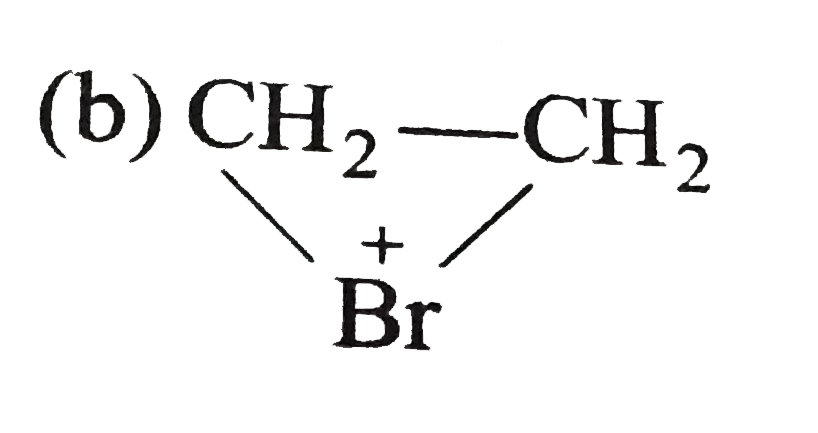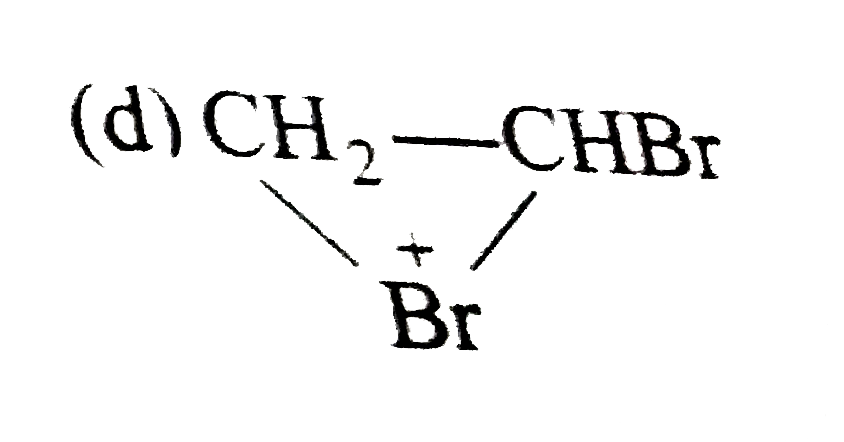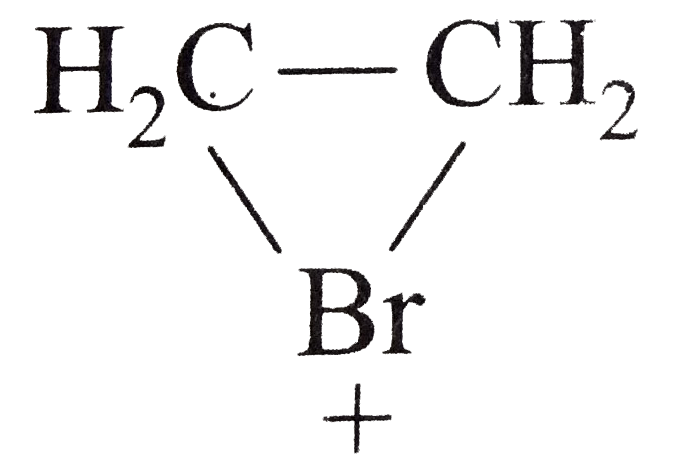Ethylene reacts with Br2 to give 1,2-dibromoethane.The anti addition takes place due to the formation of which intermediate?
CH2Br−+CH2

BrCH−CH+

The correct Answer is:D
To solve the question of how ethylene reacts with bromine to form 1,2-dibromoethane through anti-addition, we can break down the process into several steps:
Step 1: Understanding the Reactants
Ethylene (C2H4) has a double bond between the two carbon atoms. The structure can be represented as:
CH2=CH2
Step 2: Reaction with Bromine
When ethylene reacts with bromine (Br2), the double bond acts as a nucleophile and attacks one of the bromine atoms. This leads to the formation of a cyclic bromonium ion intermediate.
Step 3: Formation of the Bromonium Ion
As the double bond attacks one of the bromine atoms, the bond between the bromine atoms breaks. This results in the formation of a bromonium ion, which is a three-membered cyclic structure where one bromine atom is positively charged and is bonded to both carbon atoms of the ethylene:
Br+C2H4
Step 4: Nucleophilic Attack
The negatively charged bromide ion (Br-) that was released during the formation of the bromonium ion can now attack the more substituted carbon atom of the bromonium ion. This attack occurs from the opposite side of the bromonium ion, leading to anti-addition.
Step 5: Final Product Formation
This results in the formation of 1,2-dibromoethane (CH2Br-CH2Br), where the two bromine atoms are added to opposite sides of the original double bond:
CH2Br−CH2Br
Conclusion
The anti-addition occurs due to the formation of the bromonium ion intermediate, which allows the bromide ion to attack from the opposite side, leading to the final product.
Answer
The anti-addition takes place due to the formation of the bromonium ion intermediate.
---
Ethylene (C2H4) has a double bond between the two carbon atoms. The structure can be represented as:
CH2=CH2
When ethylene reacts with bromine (Br2), the double bond acts as a nucleophile and attacks one of the bromine atoms. This leads to the formation of a cyclic bromonium ion intermediate.
As the double bond attacks one of the bromine atoms, the bond between the bromine atoms breaks. This results in the formation of a bromonium ion, which is a three-membered cyclic structure where one bromine atom is positively charged and is bonded to both carbon atoms of the ethylene:
Br+C2H4
The negatively charged bromide ion (Br-) that was released during the formation of the bromonium ion can now attack the more substituted carbon atom of the bromonium ion. This attack occurs from the opposite side of the bromonium ion, leading to anti-addition.
This results in the formation of 1,2-dibromoethane (CH2Br-CH2Br), where the two bromine atoms are added to opposite sides of the original double bond:
CH2Br−CH2Br
The anti-addition occurs due to the formation of the bromonium ion intermediate, which allows the bromide ion to attack from the opposite side, leading to the final product.
The anti-addition takes place due to the formation of the bromonium ion intermediate.
Topper's Solved these Questions
- HYDROCARBONS (ALKANE, ALKENE and ALKYNE)BOOK - HIMANSHU PANDEYCHAPTER - HYDROCARBONS (ALKANE, ALKENE and ALKYNE)EXERCISE - Level 2 (Q.1 To Q.25)
24 Videos
- HYDROCARBONS (ALKANE, ALKENE and ALKYNE)BOOK - HIMANSHU PANDEYCHAPTER - HYDROCARBONS (ALKANE, ALKENE and ALKYNE)EXERCISE - Level 2 (Q.26 To Q.50)
25 Videos
- HYDROCARBONS (ALKANE, ALKENE and ALKYNE)BOOK - HIMANSHU PANDEYCHAPTER - HYDROCARBONS (ALKANE, ALKENE and ALKYNE)EXERCISE - Subjective Type Problems
10 Videos
Similar Questions
Knowledge Check
Ethylene reacts with S2Cl2 to give
AMustard gasBLewisiteCThiopheneDEthanethiolEthylene reacts with Br2 to give 1,2-dibromoethane. The reaction proceeds through the formation of the intermediate
ABrCH2+CH2BBrCH=+CHC D
D
Phenol reacts with Br2 in H2O to give
Am-bromophenolBo and p-bromophenolCp-bromophenolD2, 4, 6-tribromphenol
Anti markwnikoff's addition takes place in the reactions
View SolutionAnti markovnikov's addition takes place in the presence of
View Solutionn-Butane reacts with Br2 at 130∘ to give more amount of
View SolutionAnti Markownikov addition takes place in which of the following reactions
View Solution1,2−dibromoethane when heated with alcohilic potash gives
View Solution
